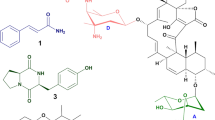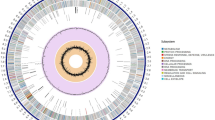Abstract
The members of Streptomyces have been identified as a major source of antimicrobial agents with broad spectrum. This study is mainly focused on bioactivity-guided isolation and characterization of bioactive molecule from strain Streptomyces sp. T1317-0309 and its whole-genome sequence analysis for possible isolation of novel natural products. Strain Streptomyces sp. T1317-0309 showed 100% sequence similarity with strain Streptomyces lannensis TA4-8T consisting 10, 453,255 bp of genome with 5 scaffolds and 69.9 mol% G + C content. The genome analyses revealed a total of 17 putative biosynthetic gene clusters (BGCs) responsible for various secondary metabolites including actinomycin, bacteriocin, ectoine, melanin, terpene, siderophore, betalactone, NRPS, T2PKS, and T3PKS. The BGC and bioactivity-guided purification of ethyl acetate extract of strain T1317-0309 showed the great potency of antimicrobial activities against various gram-positive multi-drug resistant human pathogens including MRSA. The BGC-predicted bioactive secondary metabolite was identified by various NMR analyses and confirmed as actinomycin D. In addition, this study reveals the first genome study of Streptomyces lannensis as a novel source for actinomycin D.
This is a preview of subscription content, access via your institution
Access options
Subscribe to this journal
Receive 12 print issues and online access
$259.00 per year
only $21.58 per issue
Buy this article
- Purchase on Springer Link
- Instant access to full article PDF
Prices may be subject to local taxes which are calculated during checkout



Similar content being viewed by others
References
Prestinaci F, Pezzotti P, Pantosti A. Antimicrobial resistance: a global multifaceted phenomenon. Pathog Glob Health. 2015;109:309–18.
Dahal RH, Chaudhary DK. Microbial infections and antimicrobial resistance in Nepal: current trends and recommendations. Open Microbiol J. 2018;12:230–42.
Terra L, et al. A novel alkaliphilic Streptomyces inhibits ESKAPE pathogens. Front Microbiol. 2018;9:2458.
Lewis K. Platforms for antibiotic discovery. Nat Rev Drug Disco. 2013;12:371–87.
Dryden MS, et al. Predictors of mortality in Staphylococcus aureus Bacteremia. Clin Microbiol Rev. 2011;25:362–86.
Dahal RH, Shim DS, Kim J. Development of actinobacterial resources for functional cosmetics. J Cosmet Dermatol. 2017;16:243–52.
Schneider O, et al. Genome mining of Streptomyces sp. YIM 130001 isolated from lichen affords new thiopeptide antibiotic. Front Microbiol. 2018;9:3139.
Lackner H, Bahner I, Shigematsu N, Pannell LK, Mauger AB. Structures of five components of the actinomycin Z complex from Streptomyces fradiae, two of which contain 4-chlorothreonine. J Nat Prod. 2000;63:352–6.
Jones GH. Actinomycin production persists in a strain of Streptomyces antibioticus lacking phenoxazinone synthase. Antimicrob Agents Chemother. 2000;44:1322–7.
Sharma M, Manhas RK. Purification and characterization of actinomycins from Streptomyces strain M7 active against methicillin resistant Staphylococcus aureus and vancomycin resistant Enterococcus. BMC Microbiol. 2019;19:44.
Zhang X, Ye X, Chai W, Lian X-Y, Zhang Z. New metabolites and bioactive actinomycins from marine-derived Streptomyces sp. ZZ338. Mar Drugs. 2016;14:181.
Hollstein U, Breitmaier E, Jung G. Carbon-13 nuclear magnetic resonance study of actinomycin D. J Am Chem Soc. 1974;96:8036–40.
Singh SB, Genilloud O, Peláez F. Terrestrial microorganisms – filamentous bacteria. In: Mander L, Lui H-W, editors. Comprehensive natural products II. Oxford: Elsevier; 2010. p. 109–40.
Hu D, et al. Genome guided investigation of antibiotics producing actinomycetales strain isolated from a Macau mangrove ecosystem. Sci Rep. 2018;8:1–12.
Nguyen HT, et al. Streptomyces sp. VN1, a producer of diverse metabolites including non-natural furan-type anticancer compound. Sci Rep. 2020;10:1–14.
Nguyen TM, Seo C, Ji M, Paik MJ, Myung SW, Kim J. Effective soil extraction method for cultivating previously uncultured soil bacteria. Appl Environ Microbiol. 2018;84:e01145–18.
Frank JA, et al. Critical evaluation of two primers commonly used for amplification of bacterial 16S rRNA genes. Appl Environ Microbiol. 2008;74:2461–70.
Tatusova T, et al. NCBI prokaryotic genome annotation pipeline. Nucleic Acids Res. 2016;44:6614–24.
Tanizawa Y, Fujisawa T, Nakamura Y. DFAST: a flexible prokaryotic genome annotation pipeline for faster genome publication. Bioinformatics. 2018;34:1037–9.
Aziz RK, et al. The RAST server: rapid annotations using subsystems technology. BMC Genomics. 2008;9:75.
Schattner P, Brooks AN, Lowe TM. The tRNAscan-SE, snoscan and snoGPS web servers for the detection of tRNAs and snoRNAs. Nucleic Acids Res. 2005;33:W686–9.
Lagesen K, Hallin P, Rødland EA, Stærfeldt H-H, Rognes T, Ussery DW. RNAmmer: consistent and rapid annotation of ribosomal RNA genes. Nucleic Acids Res. 2007;35:3100–8.
Kanehisa M, Goto S. KEGG: Kyoto encyclopedia of genes and genomes. Nucleic Acids Res. 2000;28:27–30.
Blin K, Shaw S, Steinke K, Villebro R, Ziemert N, Lee SY, et al. antiSMASH 5.0: updates to the secondary metabolite genome mining pipeline. Nucleic Acids Res. 2019;47:W81–7.
Yoon SH, Ha SM, Kwon S, Lim J, Kim Y, Seo H, et al. Introducing EzBioCloud: a taxonomically united database of 16S rRNA gene sequences and whole-genome assemblies. Int J Syst Evol Microbiol. 2017;67:1613–7.
Kumar S, Stecher G, Tamura K. MEGA7: molecular evolutionary genetics analysis version 7.0 for bigger datasets. Mol Biol Evol. 2016;33:1870–4.
Pruesse E, Peplies J, Glöckner FO. SINA: accurate high-throughput multiple sequence alignment of ribosomal RNA genes. Bioinformatics. 2012;28:1823–9.
Yoon S-H, Ha S-M, Lim J, Kwon S, Chun J. A large-scale evaluation of algorithms to calculate average nucleotide identity. Antonie Van Leeuwenhoek. 2017;110:1281–6.
Meier-Kolthoff JP, Auch AF, Klenk H-P, Göker M. Genome sequence-based species delimitation with confidence intervals and improved distance functions. BMC Bioinform. 2013;14:60.
CLSI. M07-A10 Methods for dilution antimicrobial susceptibility sests for bacteria that grow aerobically. Approved standard-tenth ed. Wayne, PA: Clinical & Laboratory Standards Institute; 2015. www.clsi.org.
Arhin FF, et al. Effect of polysorbate 80 on oritavancin binding to plastic surfaces: implications for susceptibility testing. Antimicrob Agents Chemother. 2008;52:1597–603.
Richter M, Rosselló-Móra R. Shifting the genomic gold standard for the prokaryotic species definition. Proc Natl Acad Sci. 2009;106:19126–31.
Grant JR, Stothard P. The CGView Server: a comparative genomics tool for circular genomes. Nucleic Acids Res. 2008;36:W181–4.
Mauger AB, Thomas WA. NMR studies of actinomycins varying at the proline sites. Org Magn Reson. 1981;17:186–90.
Chen C, Song F, Wang Q, Abdel-Mageed WM, Guo H, Fu C, et al. A marine-derived Streptomyces sp. MS449 produces high yield of actinomycin X2 and actinomycin D with potent anti-tuberculosis activity. Appl Microbiol Biotechnol. 2012;95:919–27.
Praveen V, Tripathi CKM, Bihari V, Srivastava SC. Production of actinomycin-D by a new isolate, Streptomyces sindenensis. Ann Microbiol. 2008;58:109–14.
Praveen V, Tripathi CKM. Studies on the production of actinomycin-D by Streptomyces griseoruber- a novel source. Lett Appl Microbiol. 2009;49:450–5.
Praveen V, Tripathi CKM, Bihari V. Studies on optimum fermentation conditions for actinomycin-D production by two new strains of Streptomyces spp. Med Chem Res. 2008;17:114–22.
Wei Z, Xu C, Wang J, Lu F, Bie X, Lu Z. Identification and characterization of Streptomyces flavogriseus NJ-4 as a novel producer of actinomycin D and holomycin. PeerJ. 2017;2017:1–19.
Wang D, et al. Identification, bioactivity, and productivity of actinomycins from the marine-derived Streptomyces heliomycini. Front Microbiol. 2017;8:1147.
Funding
This research was supported by Basic Science Research Program through the National Research Foundation of Korea (NRF) funded by the Ministry of Education (2019R1F1A1058501).
Author information
Authors and Affiliations
Corresponding author
Ethics declarations
Conflict of interest
The authors declare that they have no conflict of interest.
Consent for publication
All the authors read, discussed, edited and approved the final draft of the manuscript and consent for publication of this manuscript was obtained.
Additional information
Publisher’s note Springer Nature remains neutral with regard to jurisdictional claims in published maps and institutional affiliations.
Supplementary information
Rights and permissions
About this article
Cite this article
Dahal, R.H., Nguyen, T.M., Pandey, R.P. et al. The genome insights of Streptomyces lannensis T1317-0309 reveals actinomycin D production. J Antibiot 73, 837–844 (2020). https://doi.org/10.1038/s41429-020-0343-0
Received:
Revised:
Accepted:
Published:
Issue Date:
DOI: https://doi.org/10.1038/s41429-020-0343-0



